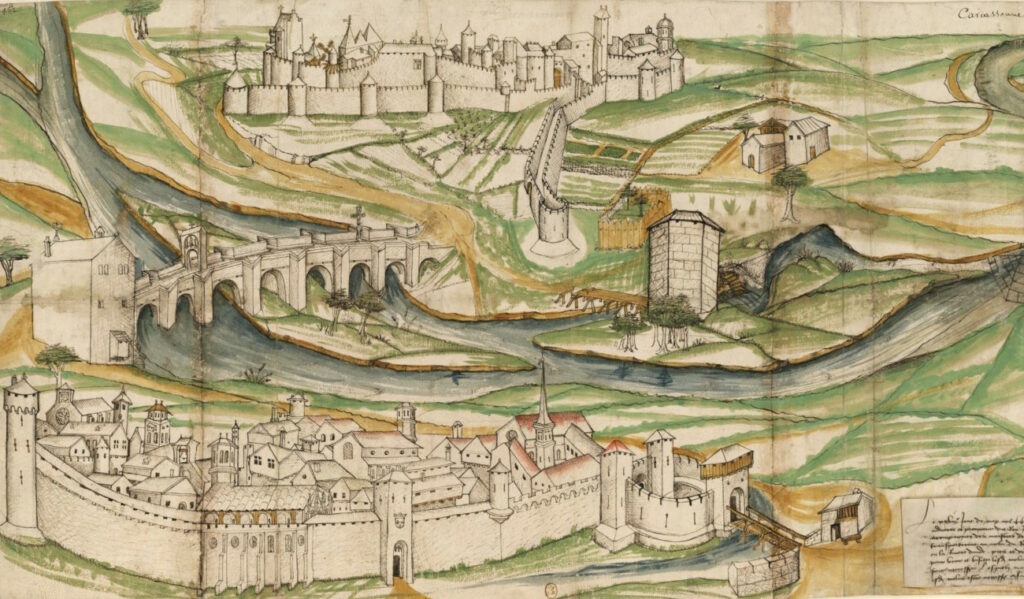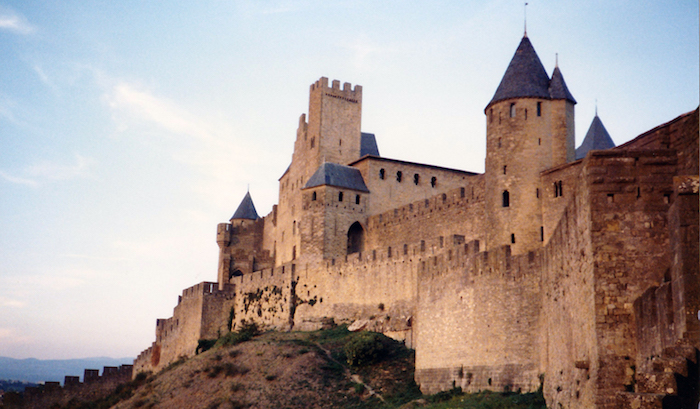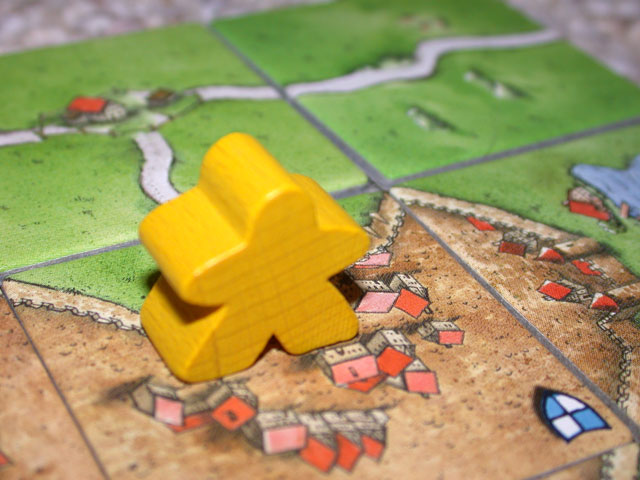Last week, we talked about the village of Montaillou around and after the year 1300 in (what is today) southern France, and how it makes a great adventure site: full of heresy, political rivalry, and interpersonal drama. This week, we’re going to look at inter-household drama in Montaillou, focusing especially on the vendetta between the the Clergue and Maurs families. It’s a wild story, full of betrayal, hypocrisy, violence, and punishment. It’s also super gameable because of an interesting quirk of household structure in Montaillou
This post is brought to you by beloved Patreon backer Joel Dalenberg. Thanks for helping keep the lights on! If you want to help keep this blog going alongside Joel, head over to the Patreon page – and thank you!

The most powerful family in Montaillou was the Clergues. They were marginally less poor than the rest of Montaillou; they had more fields and a second story on their house. The patriarch, Pons Clergue, had many sons and few daughters. Folks in Montaillou paid dowries, not bride-prices, so parents made money when their sons married and lost money when their daughters did. The Clergues thus turned a profit on the gender of their children. Pons was a diehard Cathar, but by the time we’re interested in (a bit after 1300), he was mostly out of the picture. His wife, Mengarde, ostensibly converted to Catholicism at the end of her life, but remained sympathetic to the Cathar cause and sent gifts to Cathars imprisoned in Carcassonne. When Mengarde died, the Clergues were influential enough to bury her beneath the altar of the chapel of the Virgin Mary below the village. With Mengarde out of the picture, Pons quickly lost control of the family to his two eldest sons: Pierre and Bernard.
Pierre Clergue was the village priest. Though he was the official representative of the Catholic Church in Montaillou, until 1308 he was a practicing Cathar. Even after that, he remained friendly towards Catharism and continued to own a Cathar holy book. You might call it divided loyalties, but Pierre Clergue had no religious loyalties to divide. He played whatever role was most advantageous for his family’s political position. He used his role as the Inquisition’s man in Montaillou to report his enemies and protect his friends. He was also a cad. Priests were expected to be chaste by this point, but Pierre Clergue had slept with a good fraction of the women in Montaillou and the nearby villages. He even carried out several long-term affairs, sometimes with the knowledge of the woman’s husband. These women were also useful mouthpieces for him when he needed to denounce someone to the Inquisition.
Bernard Clergue was the village bailiff. His job was to collect taxes and send them along to the Count of Foix. He also arrested criminals. This was a lucrative position, since the Count of Foix authorized his bailiffs to oversee farmland seized as punishment for crimes. If Bernard arrested you and produced witnesses to your crime in court, and if the sentence involved you losing some of your fields to the Count as punishment, the Clergues got to work your fields. Land was wealth (from wool) and security against starvation (from grain), so Bernard had a strong incentive to arrest as many people as he could. Bernard, too, was a Cathar sympathizer and through an intermediary smuggled grain to Cathars in the hills.
Brothers Pierre and Bernard were theoretically co-equal heads of the Clergue family. In practice, Bernard was the junior member of the partnership. Pierre and Bernard had two other brothers, Guillaume and Raymond, and two sisters, Esclarmonde and Guillemette. They’re not super important in this story, but it’s worth noting that Raymond’s wife, Esclarmonde Fort (there weren’t a lot of unique names in Montaillou) was one of Pierre Clergue’s mistresses and that this was technically incest under contemporary Church law.

Image credit: Chris Mitchell. Released under a CC BY-SA 4.0 license.
In 1308, Pierre Clergue (the priest) betrayed his Cathar brethren to advance his reputation in the Church. He reported to the Inquisition that the heresy in Montaillou was too far gone to address incrementally. Everyone was a suspect. The Inquisition raided the village and arrested every person, male and female, above the age of twelve. Not coincidentally, twelve was the age of reason in Catharism and Cathars theoretically did not consider anyone younger then twelve as having religion. For several months, Montaillou was occupied solely by children and animals. Eventually those the Inquisition deemed good Catholics or whose heresy was not too advanced (and were suitably repentant) were returned to Montaillou. Many others spent stints of months or years in the dungeon in Carcassonne, either until they repented of their heresy or until the Church felt they’d done suitable penance.
Among the families hardest hit by the 1308 roundup were the Maurs. Father Pierre Maurs, mother Mengarde, and sons Arnaud, Pierre, Guillaume, and Raymond Maurs were all arrested. Guillaume alone managed to avoid a prison sentence. Pierre (the father) and Arnaud vanish from the record as far as I can tell, suggesting they died in prison. The dungeon at Carcassonne was healthier than most, but it was still a dungeon and disease was a constant danger. Even a short stint could prove fatal. When Mengarde, Pierre (the son), and Raymond were released from prison, mother Mengarde had some harsh words to say about the treacherous priest who ordered their village raided. The Clergue family retaliated. Bernard Clergue (the bailiff) had Mengarde Maurs brought up on charges of bearing false witness. The punishment ordered by his distant superiors was that her tongue be cut out.
Guillaume Maurs, the only member of the family to escape a prison sentence, swore revenge on the Clergue family. Pierre Clergue (the priest), in turn, swore to destroy the entire Maurs family. Both included in their oaths not just the blood relatives of their rivals, but everyone who so much as lived in their homes (more on this later). This had nothing to do with Catharism and Catholicism. To Guillaume Maurs, it was about a father and brother killed and a mother mutilated. To Pierre Clergue, it was about an insult to his family’s good name and social standing.

Image credit: Krzystztof Golik. Released under a CC BY-SA 4.0 license.
The surviving Maurs men fled Montaillou and became wandering shepherds. In 1309, Guillaume Maurs, Raymond Maurs, and one man not from the family swore on bread and wine that they would pool their resources and kill Pierre Clergue. They made several assassination attempts, but none succeeded. Guillaume Maurs in particular was so obsessed with his vendetta that Catholic priests refused to offer him communion because after hearing him in confession, they determined he was too unrepentantly wrathful to receive the sacrament. The Clergue family too continued its persecution. Raymond Clergue (an unimportant brother) took the minor knight Jacques Alsen with him to unsuccessfully pursue the Maurs brothers across the Pyrenees into Spain.
Exiled and wandering, the Maurs family soured. Their former standing in Montaillou grew in the retelling, making the wrongs against them all the greater. In 1317, Guillaume Maurs brought two assassins across the mountains from Catalonia and promised them an extraordinary sum if they killed the priest Pierre Clergue. This attempt failed when Pierre Maurs, the least-obsessed Maurs brother, backed out.
The Maurs family never got their revenge; the Inquisition got the Clergues first. In 1317, a new bishop took the reins. He was much more active than his predecessors. Among other things, he insisted Pierre Clergue collect the full tithes due the Church. Overlooking tithes was an important favor Pierre Clergue used to stay popular in Montaillou. He also skimmed a little off the top and distributed it to his allies. No longer able to do either, he couldn’t keep the villagers happy. People started to turn on him. They traveled to other towns to report to the Inquisition that the Clergue family had long associated with Cathars, and these witnesses were even able to offer names and dates so other witnesses could corroborate their claims. Bernard and Pierre went to prison. While locked up, Bernard (the former bailiff) tried to get some of his friends to falsely testify to the Clergue family’s innocence, but no one was willing to risk burning at the stake for perjury on his behalf. Bernard Clergue died in prison in 1324, only a month into his sentence. I’m not sure what happened to the rest of the Clergues, but a similar fate seems likely.

There’s an additional complication to this story I haven’t mentioned until now. I’ve been talking about this vendetta as a feud between families, but that’s not how the participants saw it. The Latin word familia (family and relatives) rarely appears in our source, the Fournier Register. Instead, the words present are Latin words for houses: in the native Occitan language, ostal. It was the ostal, the house itself, that was the unit by which Montaillou organized itself. Theoretically, an ostal contained a married couple and its dependents. In practice, an ostal was more complex. There might be more than one married couple, usually male siblings and their wives, but sometimes including their married parents if both parents lived long enough to see their children marry. Concubinage was condemned by the Church but widely practiced, so unmarried (or even married!) men might have a concubine in their ostal too. You also had ‘domestics’: people with no blood family to speak of (thanks to accident, disease, or war) who joined an existing ostal and fully participated in the labor of the household: cooking, mending, and working in the field beside their housemates as peers. And a big house might have boarders who did not participate in the labor of the house, but paid for a bed and meals while they plied some other trade. You also had all the bastard and natural-born children of all these adults. Finally, an ostal contained nail clippings and locks of hair of deceased members of the ostal. Keeping these mementoes kept the dead from taking their portion of the ostal’s good fortune with them to the other side.
The ostal was, by and large, a united front. The five Catholic ostals of Montaillou had Catholic residents. The eleven Cathar ostals had Cathar residents. The twenty-five-ish pseudo-Cathar ostals had residents at various points on the sliding scale, but few zealots from either end. If a Perfect or traveling priest converted the ostal’s head of household, the rest of the ostal usually followed suit. The head of household was usually the oldest married man. That meant if you were a man and your son got married and brought his wife to live in your ostal, your days as head of household were numbered. If you outlived your wife, you would soon find your star eclipsed as the other members of your ostal took progressively more and more cues from your oldest married son – though obviously there was huge room for variety there. Women got a raw deal, though they usually rose in influence as they aged, unlike men. About the best a woman could hope for was to be a grandmother living with one or more of her grown male children, with her (invariably abusive) husband long since buried. The Fournier Register is seldom pretty, but the lives of women it illuminates tend to be among the worst.

What’s so important about this ‘ostal’ business is how gameable it is. If anyone who is living in a household is part of its feuds, it’s easier than ever to involve your PCs in drama. If one or more of your PCs are boarding in a fictional household you based on the Clergue or Maurs ostals, then the ostal’s vendetta is the party’s vendetta. Even if the PCs try to wash their hands of the affair, the feuding NPCs won’t. If the PCs are part of the Clergue-analogue ostal, your NPC based on Guillaume Maurs still wants to have them assassinated. If the party is part of the Maurs-analogue ostal, your Clergue-analogues will still try to destroy them. Even if you can’t get your PCs into a relevant ostal, you can certainly do the same with NPCs. Just put one or two NPCs the players like in an ostal that’s about to start a vendetta, and bam! Now the PCs have ties to this feud.
Alternatively, let’s say the ‘ostal’ construct is hard to port to your fictional campaign setting. Maybe it’s a setting like a Jane Austen novel, which has pre-existing rules on how families work which are both known to the players and important to the feel of the setting. Bringing in an ostal-based feud would feel weird. That’s fine! Even if you can’t use the ostal to make things easier, the vendetta between the Maurs and the Clergues is still wonderful and gameable. You just have to find other ways to involve the party.
One way is ideological. In real life, this feud was about power politics and revenge, not really about Catharism and Catholicism. But maybe your fictional versions of Guillaume Maurs and Pierre Clergue really do care strongly about an unorthodox religious or political belief (Maurs) and selling that belief out to the orthodox one (Clergue). If you pick an ideology the PCs are invested in, then they now have a reason to get involved in the vendetta. Another avenue is political. If the PCs need a favor from one or another participant in the feud, maybe the party can scratch the NPC’s back so the NPC will scratch theirs. A third way – if you have the right sorts of PCs and players – is moral. If you set the feud up right, the party might get involved simply because it’s the right thing to do.
Source: Montaillou: Cathars and Catholics in a French Village 1294-1324 by Emmanuel Le Roy Ladurie (1978)






